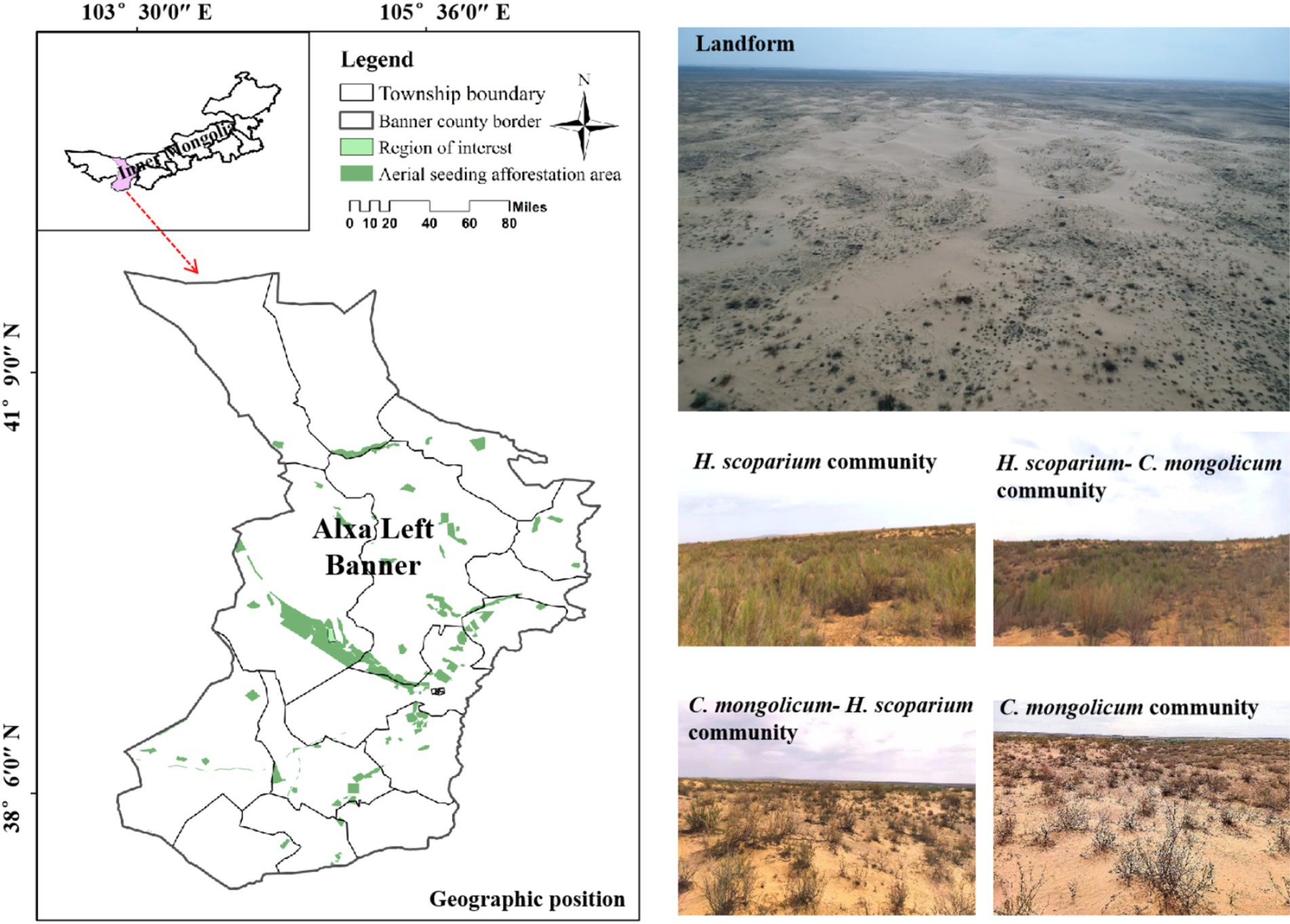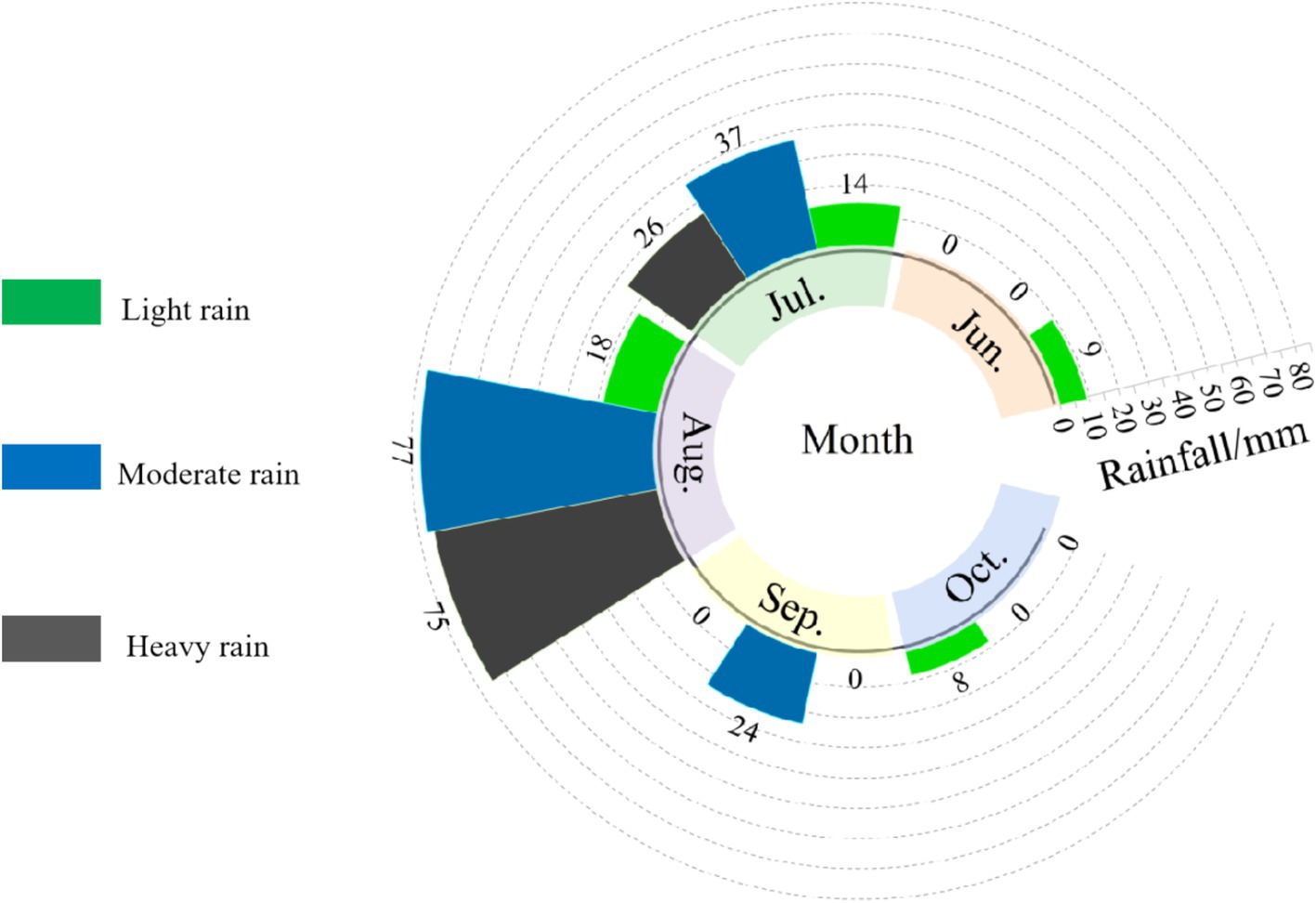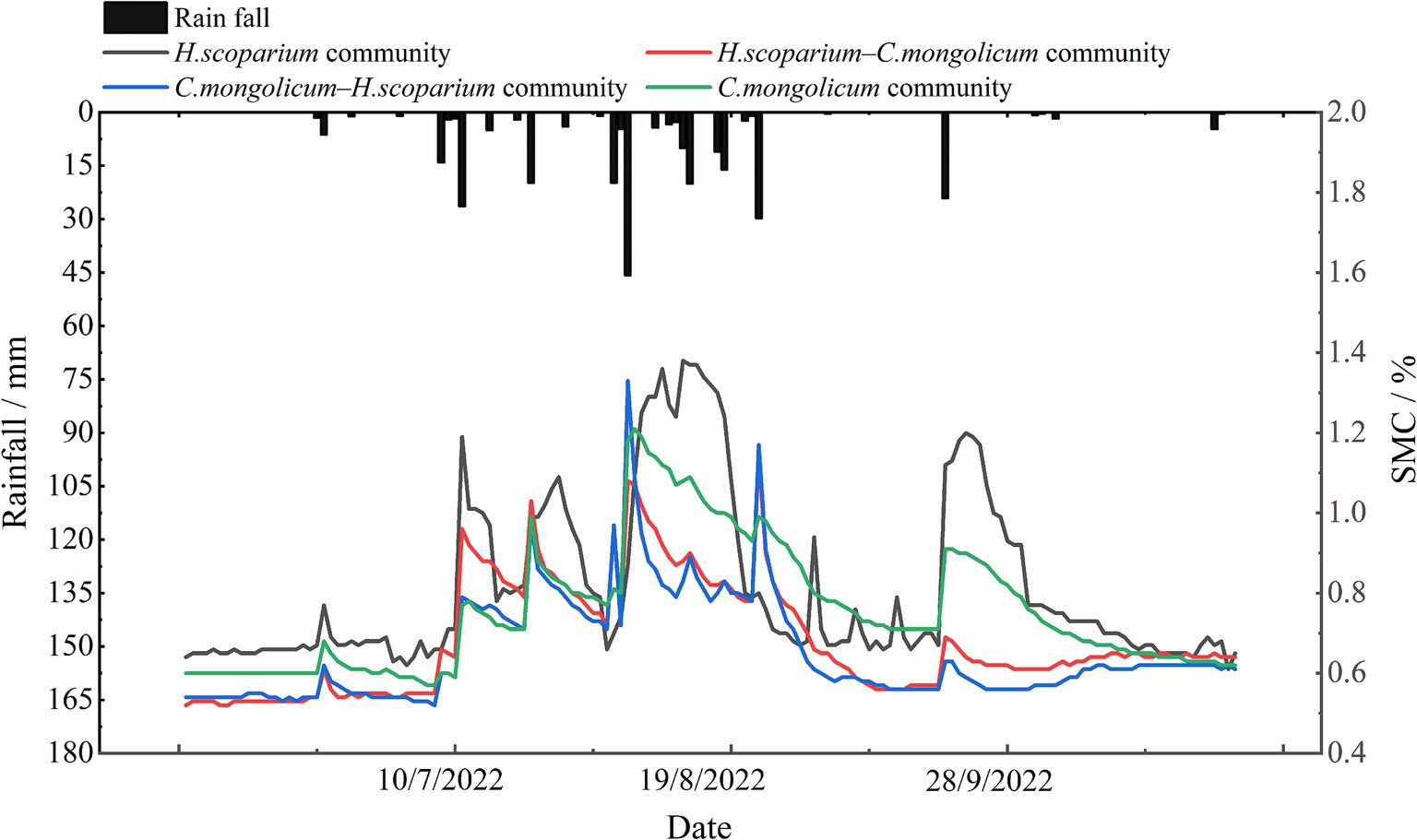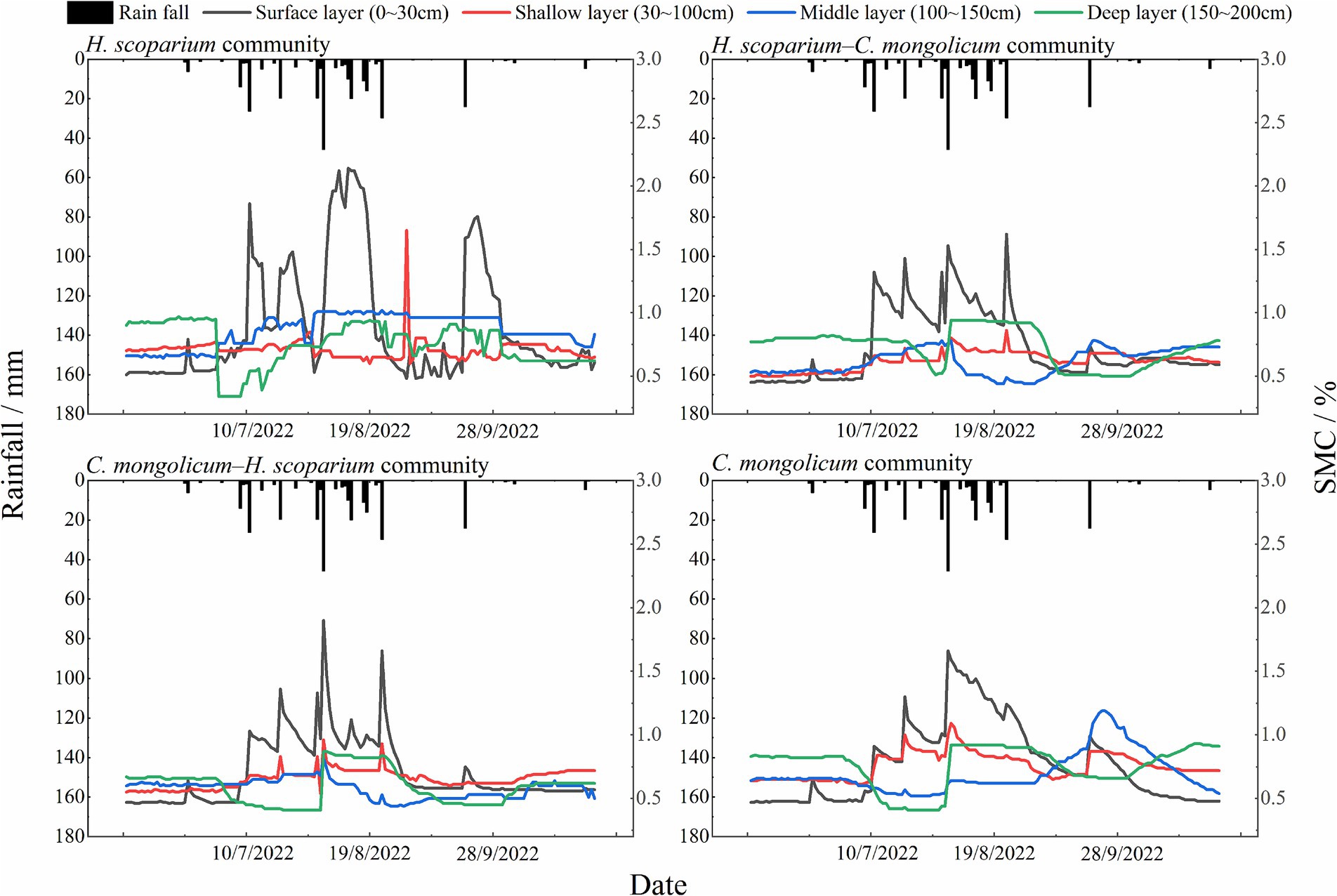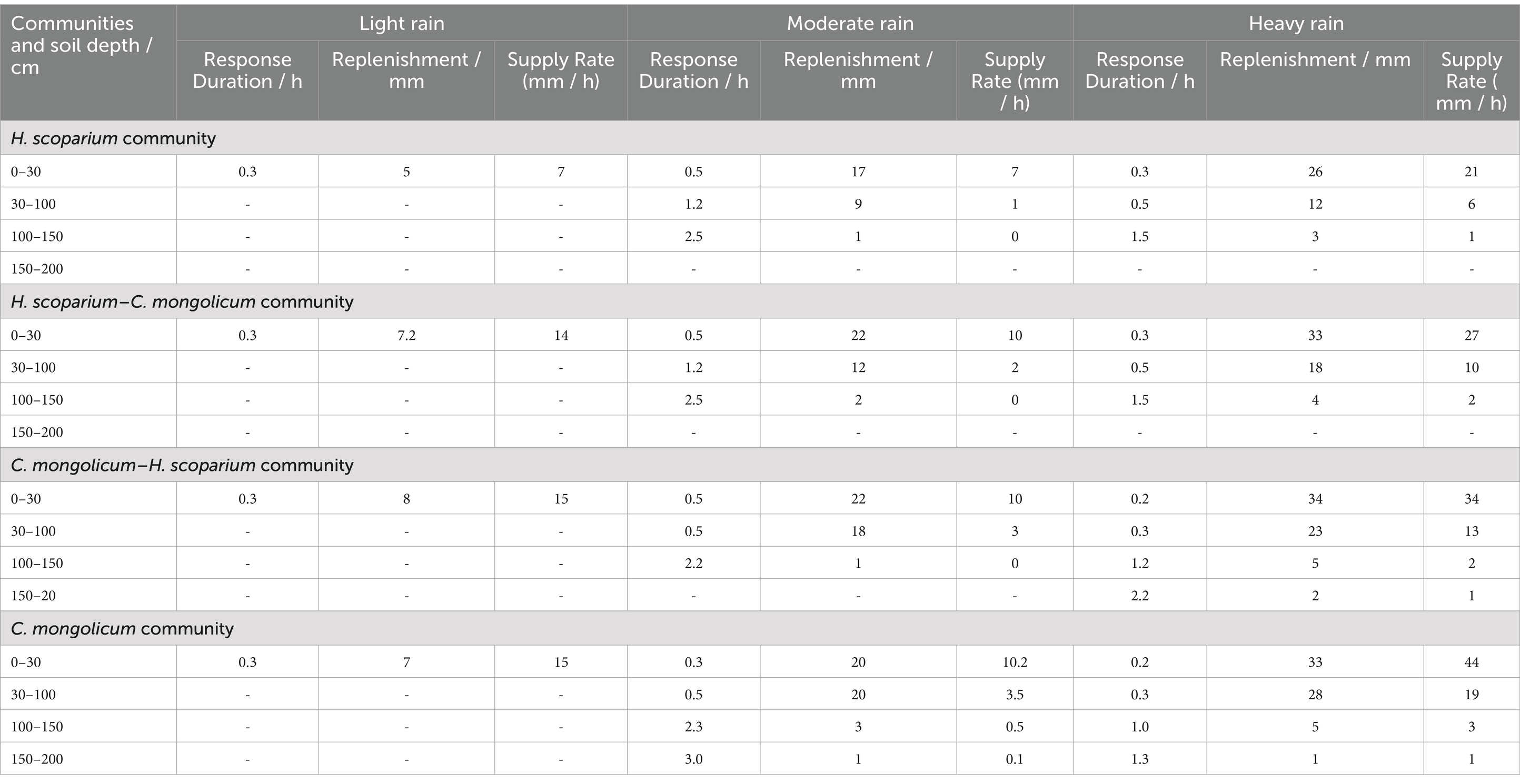- 1Yinshanbeilu Grassland Eco-hydrology National Observation and Research Station, China Institute of Water Resources and Hydropower Research, Beijing, China
- 2Institute of Water Resources for Pastoral Area, Ministry of Water Resources, Hohhot, China
Studying the characteristics of soil moisture in afforestation area and its response to different grades of rainfall is helpful to quantitatively analyze the change law of soil moisture in afforestation area and provide theoretical basis for rational and efficient use of soil moisture. In this study, four artificial plant communities were selected, including Hedysarum scoparium community, Calligonum mongolicum community, H. scoparium- C. mongolicum community and C. mongolicum- H. scoparium community. The soil moisture content, soil moisture storage and their response characteristics to different grades of rainfall from June to October were compared and analyzed. The results showed that the SMC of H. scoparium- C. mongolicum community and C. mongolicum- H. scoparium community were lower than that of H. scoparium community and C. mongolicum community. The coefficient of variation of soil moisture content in C. mongolicum community was the largest, which was 22.7%, and the coefficient of variation of soil moisture content in H. scoparium-C. mongolicum community was the smallest, which was 19.4%. The recharge of rainfall to soil moisture storage of four artificial plant communities was different. The recharge of different grades of rainfall to soil moisture storage of C. mongolicum community and C. mongolicum-H. scoparium community was higher than that of H. scoparium community and H. scoparium-C. mongolicum community. In general, the utilization of soil moisture content in different soil layers by H. scoparium-C.mongolicum community is more balanced, and the soil moisture content in each soil layer is less affected by rainfall and has higher stability. Therefore, considering the configuration mode of H. scoparium- C. mongolicum community in the future aerial seeding afforestation process is conducive to the rational and efficient utilization of soil moisture in the afforestation area.
1 Introduction
The Tengger Desert is a typical arid desert area with sparse vegetation and strong wind-sand activities. It is a key area for wind-sand prevention and control in China (Shi et al., 2023). In the 1950 s, in order to effectively curb the further spread of desertified land in the Tengger Desert, China successively launched the ‘Three North Shelterbelt Construction Project ‘and the ‘Beijing-Tianjin Sandstorm Source Control Project ‘in the Tengger Desert, and began large-scale aerial seeding. Afforestation has rapidly increased vegetation coverage in the Tengger Desert (Shao et al., 2023; Li et al., 2023).
In the process of aerial seeding afforestation, in order to improve the efficiency of aerial seeding afforestation and the survival rate of aerial seeding, researchers have carried out various experimental studies in the Tengger Desert. For example, the organic–inorganic composite binder was prepared and used to study the effect of different raw material ratios on the disintegration time of Calligonum mongolicum (C. mongolicum) seeds (Zhang et al., 2006). The results showed that the weight of the seeds increased by 3–5 times after treatment, and the water absorption was higher, which successfully solved the problem of desert aerial seeds floating with the wind. The optimum time of aerial seeding and the suitable area for seeding in Tengger Desert were studied. The results showed that the most favorable time for seed germination and seedling formation was from late June to early July, with flat low-moving dunes with shallow dry sand layers or lowlands between medium and high, and a height of 5–10 m suitable for seeding (Tian et al., 2010). By studying the stability of artificial plants such as C. mongolicum and Hedysarum scoparium (H. scoparium) in aerial seeding afforestation area, the results show that C. mongolicum has high stability potential (Cao et al., 2013). These studies provide a strong theoretical support for the development of aerial seeding afforestation technology in China.
Practice has proved that after years of continuous aerial afforestation, the construction of forest and grass protection belt in Tengger Desert has been greatly developed, which has firmly locked the expansion and spread of desertification land and forward tilt hazards, and effectively improved the regional ecological environment (Guan et al., 2016). However, with the passage of time, artificial plants in some aerial seeding areas have declined or even died. The reason is that the configuration of aerial seeding seeds and the characteristics of environmental factors in afforestation sites are not fully considered in the process of aerial seeding afforestation.
Soil moisture is the material basis of plant growth and one of the most important factors restricting ecological restoration in arid desert areas (Xia and Shao, 2009). Precipitation is an important source of soil moisture supply in arid desert areas. It has an important impact on the process of ecosystem construction, soil erosion and microclimate changes in arid desert areas, and is a key factor in exploring ecological restoration in desert areas (Yu et al., 2018; Muldavin et al., 2008; Lee et al., 2007). Studying the characteristics of soil moisture and its response to rainfall is helpful to quantitatively analyze the variation of soil moisture and provide a theoretical basis for rational and efficient use of soil moisture. At present, researchers have studied the characteristics of soil moisture in arid desert areas. It has been found that soil moisture connet (SMC) in 5–40 cm soil layer has obvious seasonal variation, showing the characteristics of three high and three low, and with the deepening of depth, the correlation between SMC in upper and lower soil layers gradually weakens (Zhang M. et al., 2012). The distribution pattern of surface SMC is regulated by soil hydraulic characteristics. Rainfall events have disturbed or restored this pattern, but this pattern is re-established during soil drying (Yamanaka et al., 2007). The difference of SMC in 0–10 cm soil layer was significant (Liang and Qian, 2016). The above studies are mostly focused on the study of soil moisture content under single vegetation type or site conditions, while there are few reports on the study of soil moisture characteristics of different artificial plant communities. The variation of soil moisture in different artificial plant communities under rainfall conditions is not yet clear.
Thus, this study takes four typical artificial plant communities in the aerial seeding afforestation area in the northeastern margin of the Tengger Desert as the research object. Through the long-term observation of SMC and rainfall in the four artificial plant communities, the soil moisture characteristics of the four artificial plant communities are revealed, and the variation of soil moisture characteristics under different grades of rainfall is deeply explored. The results of the study are intended to provide a scientific basis for the selection of plant configuration modes for aerial seeding afforestation in arid desert areas in the future, the assessment of moisture carrying capacity in aerial seeding afforestation areas, and the reseeding of degraded forest areas.
2 Manuscript formatting
2.1 Study site
As shown in Figure 1, the study area is located in the northeastern margin of the Tengger Desert in Alxa Left Banner (39°11′-39°18′N,104°53′-104°57′E). It belongs to a typical arid desert area. The soil type is mainly non-zonal eolian sandy soil, with an average SMC of 0.47–1.28%, an average annual precipitation of 100–300 mm, and an annual evaporation of 2,900–3,300 mm (Zhang J. H. et al., 2008; Zhang et al., 2021; Shi et al., 2004). The annual average wind speed is 1.9 m·s−1, and the maximum wind speed can reach 26 m·s−1 (Zhao et al., 2023). The number of strong wind days is mostly in spring and winter, and the main wind direction is northwest wind (Zhang K. C. et al., 2012; Zhang et al., 2014; Lü et al., 2009). Before the implementation of aerial seeding, the study area was dominated by mobile dunes. In 1992, aerial seeding was conducted by mixing H. scoparium and C. mongolicum. After more than 30 years of vegetation restoration, the dune types in the study area were basically converted to fixed dunes. The plant species are mainly aerial shrubs such as H. scoparium and C. mongolicum, accompanied with xerophytes such as Allium mongolicum, Stipa capillata, Bassia dasyphylla, and Agriophyllum squarrosum (Zhao et al., 2019; Wang et al., 2013; Liu et al., 2010; Fan et al., 2011).
2.2 Research methods
2.2.1 Basic information of plots
In June–October 2022, four different artificial plant communities were selected in the study area, namely, H. scoparium community, H. scoparium-C. mongolicum community, C. mongolicum-H. scoparium community and C. mongolicum community. The SMC monitoring equipment WatchDog 2,400 and the rain gage were placed in a relatively flat area in each community plot to obtain long-term SMC data and rainfall. The buried depths of the SMC monitoring equipment probes were 0–10 cm, 10–20 cm, 20–30 cm, 30–60 cm, 60–100 cm, 100–150 cm, and 150–250 cm. The monitoring data were soil volumetric moisture content. In this experiment, six 20 m × 20 m shrub quadrats were set up in each experimental plot in accordance with the checkerboard method, and five 1 m × 1 m herb quadrats were set up in each shrub quadrat by using the five-point method to investigate the basic information of vegetation and plots (Table 1).
2.2.2 Data processing
In this study, combined with the actual situation of SMC in the aerial seeding afforestation area, the soil layer was divided into four layers: surface layer (0–30 cm), shallow layer (30–100 cm), middle layer (100–150 cm) and deep layer (150–200 cm), in order to better analyze the SMC characteristics of four artificial plant communities in each soil layer. The rainfall with an interval of more than 24 h is regarded as two independent rainfall events (Zheng et al., 2016). According to the classification standard of rainfall issued by China Meteorological Administration, the 24-h rainfall is divided into three grades: light rain (<10 mm), moderate rain (10–25 mm), and heavy rain (25–50 mm).
Based on the continuous monitoring data of SMC and rainfall in each community, the recharge amount, response time and recharge rate of soil moisture storage (SMS) in each community in different rainfall events were analyzed to analyze the recharge characteristics of SMS in four artificial plant communities in rainfall events. Equations for each index are calculated as follows (Equations 1–5) (Zhang et al., 2022; Yuan et al., 2022; Zhu et al., 2014):
In the formula, ΔSWi is the recharge of rainfall to the i layer (mm); SWi, max is the maximum value of SMS in the i layer after rainfall (mm), and SWi,0 is the initial value of SMS in the i layer before rainfall. Δts is the response time of SMC in the i layer after rainfall; t0 is the beginning time of rainfall, and ti is the beginning time of SMC in the i layer after rainfall. Δtr is the time when the SMC in the i layer reaches the peak after rainfall, and ti, max is the time when the SMC in the i layer reaches the peak after rainfall. V is the SMS recharge amount rate; w is the SMS of 0–200 cm (mm); θi is the soil volumetric moisture content of each layer measured by a SMC sensor (m−3/m−3), and di is the corresponding soil depth (mm).
2.2.3 Data analysis
SPSS 26 and Origin 2021 software were used to analyze and map the data. One-way analysis of variance was used to compare the SMC content of different communities and different soil layers, and the coefficient of variation (CV) was calculated to analyze the stability of SMC in each soil layer.
3 Results
3.1 Rainfall characteristics in the study area during the monitoring period
As shown in Figure 2 the total rainfall in the study area during the monitoring period (June to October) was 288 mm, of which the rainfall in August was the most, reaching 170 mm, and the rainfall in October was the least, only 8 mm. During the monitoring period, the rainfall was mainly distributed from July to August, accounting for 86% of the total rainfall during the monitoring period, with a strong single-peak feature. Based on the number of rainfalls and the maximum rainfall in each month, three rainfalls were reported in June, and the maximum rainfall was 6 mm. There were nine times of rainfall in July, and the maximum rainfall was 26 mm. There were 13 times of rainfall in August, and the maximum rainfall was 46 mm. There were two times of rainfall in September, and the maximum rainfall was 24 mm. There were five times of rainfall in October, with the maximum rainfall of 11 mm.
During the monitoring period, a total of 33 rainfall events were recorded, including 22 times of light rain, eight times of moderate rain, and three times of heavy rain, accounting for 66.67, 24.24 and 9.09% of the rainfall events, respectively. The total rainfall of light rain, moderate rain, and heavy rain were 49, 138, and 101 mm, respectively, accounting for 16.93, 47.97, and 35.10% of the total rainfall. The rainfall events during the monitoring period were dominated by light rain, which contributed 16.93% of the rainfall during the monitoring period, while moderate rain and heavy rain only accounted for 33.3% of the total rainfall, but contributed 83.07% of the rainfall.
3.2 SMC characteristics of four artificial plant communities
As shown in Figure 3 the SMC of four artificial plant communities changed significantly with time during the monitoring period, showing a trend of increasing first and then decreasing. The SMC was the highest in August and the lowest in June, which was consistent with the distribution characteristics of rainfall. The SMC of H. scoparium community from June to October was 0.67, 0.85, 1.01, 0.84 and 0.70%, respectively. The SMC of C. mongolicum-H. scoparium community was 0.54, 0.76, 0.86, 0.61 and 0.64%, respectively. The SMC of C. mongolicum-H. scoparium community was 0.55, 0.70, 0.84, 0.58 and 0.61%, respectively. The SMC of C. mongolicum community was 0.61, 0.72, 0.99, 0.79 and 0.67%, respectively. During the monitoring period, the average SMC of four artificial plant communities showed H. scoparium community > C. mongolicum community > H. scoparium- C. mongolicum community > C. mongolicum- H. scoparium community.
As shown in Figure 4 and Table 2, it can be seen that the variation coefficient of SMC in four artificial plant communities with soil depth is the largest in C. mongolicum community and the variation coefficient of SMC in H. scoparium-C. mongolicum community is the smallest. With the increase of rainfall, the SMC of four artificial plant communities fluctuates the most in the surface layer.
The average SMC in the surface, shallow, middle and deep layers of the H. scoparium community was 0.75, 0.87, 0.83 and 0.75%, respectively. The coefficient of variation of SMC in the 0–200 cm soil layer was 20.0%. The average SMC in the surface, shallow, middle and deep layers of H. scoparium-C. mongolicum community was 0.61, 0.77, 0.66 and 0.64%, respectively. The coefficient of variation of SMC in 0–200 cm soil layer was 19.4%. The average SMC in the surface, shallow, middle and deep layers of C. mongolicum-H. scoparium community was 0.61, 0.72, 0.64 and 0.58%, respectively. The coefficient of variation of SMC in 0–200 cm soil layer was 20.3%. The average SMC in the surface, shallow, middle and deep layers of C. mongolicum community was 0.77, 0.76, 0.76 and 0.72%, respectively. The coefficient of variation of SMC in 0–200 cm soil layer was 22.7%. The SMC of H. scoparium community in four artificial plant communities was significantly higher than that of H. scoparium-C. mongolicus community and H. scoparium-C. mongolicus community.
3.3 Effects of rainfall on four artificial plant communities
In order to clarify the response characteristics of SMC of four artificial plant communities to rainfall, three typical rainfalls of heavy rain, moderate rain and light rain were selected for analysis. The rainfalls were 6 mm, 20 mm and 30 mm, respectively.
As shown in Figure 5 that in the light rain event, the response of four artificial plant communities to rainfall was not obvious, and the change range was small. The SMC was the largest on the day of rainfall event, showing H. scoparium community (0.73%) > C. mongolicum community (0.68%) > C. mongolicum-H. scoparium community (0.62%) > H. scoparium- C. mongolicum community (0.61%). In the moderate rain event, the SMC of four artificial plant communities responded significantly to rainfall, and the SMC increased significantly after the rainfall event. The SMC on the day of rainfall showed H. scoparium community (1.07%) > H. scoparium-C. mongolicum community (1.03%) > C. mongolicum community (0.99%) > C. mongolicum-H. scoparium community (0.97%); in the heavy rain event, the SMC of four artificial plant communities responded strongly to rainfall, and the SMC changed greatly. On the day of rainfall event, the SMC showed H. scoparium community (1.26%) > C. mongolicum-H. scoparium community (1.17%) > H. scoparium- C. mongolicum community (1.14%) > C. mongolicum community (0.99%). In the three typical rainfalls, the SMC of the H. scoparium community was higher than that of other plant communities.
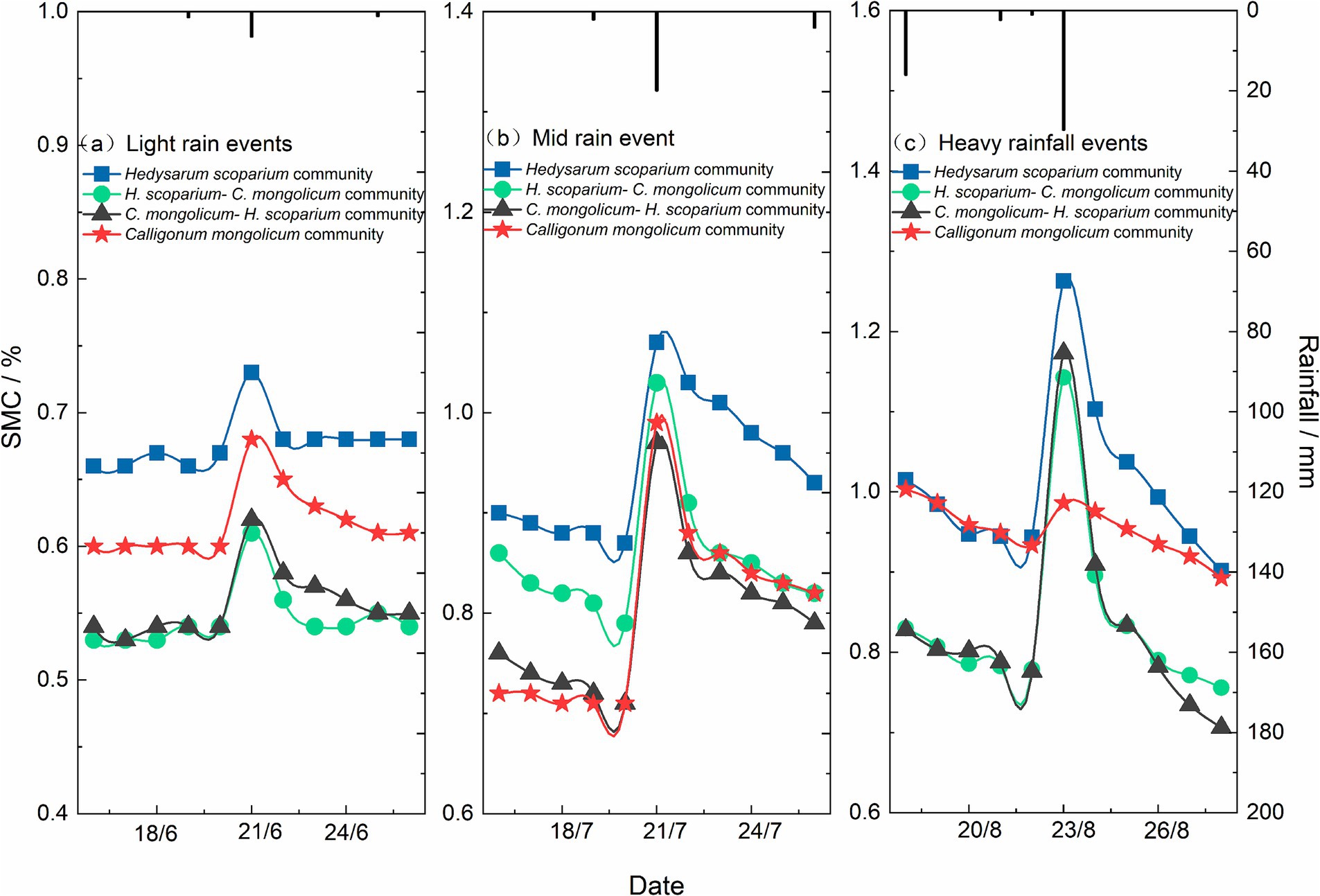
Figure 5. Changes of SMC in different rainfall events. (A) Light rain events. (B) Mid rain event. (C) Heavy rainfall events.
3.4 SMS supply characteristics of four artificial plant communities
As shown in Table 3, in the light rainfall event, the four artificial plant communities responded to the rainfall in the surface layer and had a recharge effect, but there was no response in the shallow, middle and deep layers. The SMS showed C. mongolicum-H. scoparium community (8 mm) > C. mongolicum community (7 mm) > H. scoparium–C. mongolicum community (7 mm) > H. scoparium community (5 mm), and the recharge rate was consistent with the recharge trend. In the event of moderate rainfall, the SMS of four artificial plant communities responded to rainfall in the surface, shallow and middle layers, but the response in the deep layer was not obvious. The total soil moisture supply in the 0–200 cm soil layer of the four artificial communities showed C. mongolicum community (44 mm) > C. mongolicum-H. scoparium community (42 mm) > H. scoparium-C. mongolicum community (36 mm) > H. scoparium community (27 mm). In the heavy rainfall event, the H. scoparium community and H. scoparium–C. angustifolia community responded to rainfall in the surface, shallow, and middle layers, whereas the C. mongolicum community and C. mongolicum–H. scoparium community responded to rainfall in the 0–200 cm soil layer. The total SMS supply of the four communities in the 0–200 cm soil layer showed C. mongolicum community (68 mm) > C. mongolicum–H. scoparium community (64 mm) > H. scoparium–C. mongolicum community (55 mm) > H. scoparium community (41 mm). The response of the four artificial communities to light rain, moderate rain, and heavy rain events decreased with the increase of soil depth, and the recharge rate decreased with the increase of soil depth. The law of recharge rate in each soil layer was consistent with the total recharge.
3.5 The correlation between SMS recharge and rainfall in four artificial plant communities
As shown in Figure 6, the SMS recharge amount in the surface, shallow, and middle layers of the H. scoparium community increased with the increase of rainfall, whereas the deep SMS recharge amount showed a downward trend in 10–20 mm rainfall and an upward trend in >20 mm rainfall. The surface soil moisture supply of the H. scoparium–C. mongolicum community showed an upward trend under 30 mm rainfall, and the soil moisture supply of >30 mm rainfall began to decrease. The overall trend of the shallow and middle layers was consistent with the surface layer, the deep soil moisture supply increased with the increase of rainfall. The soil moisture supply in each soil layer of the C. mongolicum–H. scoparium community and C. mongolicum community showed an upward trend with the increase of rainfall when the rainfall was more than 30 mm, and no significant correlation was found between soil supply and rainfall when the rainfall was less than 30 mm. In general, when the rainfall is less than 30 mm, no significant correlation is found among the characteristics of SMS recharge and rainfall in the four communities except for the surface soil. When the rainfall is greater than 30 mm, the effective supply of rainfall to SMS and the depth of supply increase with the increase of rainfall.
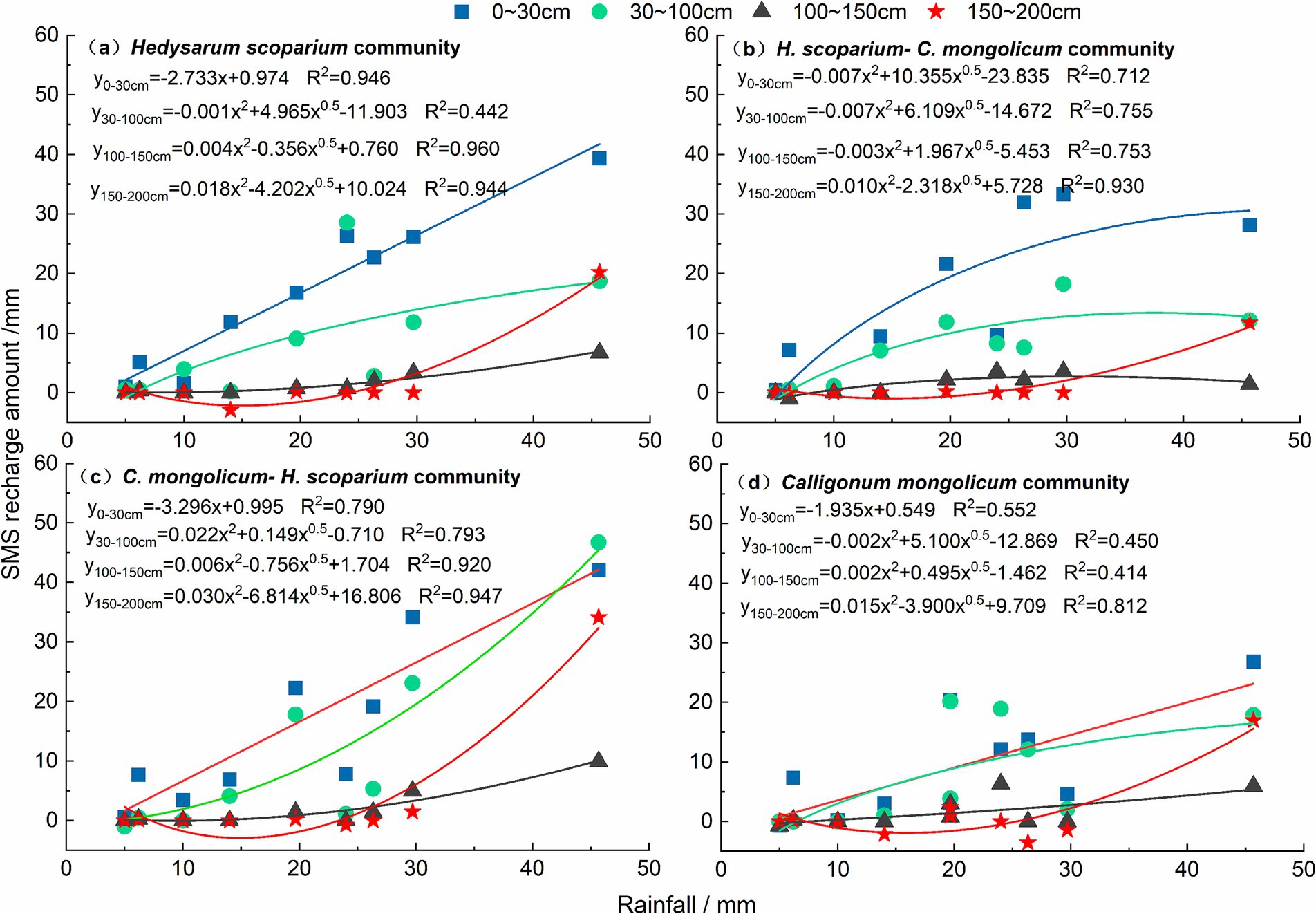
Figure 6. The correlation between rainfall and SMS recharge in different soil layers. (A) Hedysarum scoparium community. (B) H. scoparium- C. mongolicum community. (C) C. mongolicum- H. scoparium community. (D) Calligonum mongolicum community.
From the fitting R2 of soil moisture supply and rainfall, it can be seen that the R2 of the middle layer of the H. scoparium community was the highest, which was 0.960, followed by the surface layer, which was 0.946, and the shallow layer was the lowest, which was only 0.442. The R2 in the deep layer of the community was the highest, which was 0.930, and the difference of R2 in the surface layer, shallow layer and middle layer was small, which was between 0.712 and 0.755. The deep layer R2 of C. mongolicum-Radix arvensis community was the highest, which was 0.947, followed by the middle layer, which was 0.920, and the surface and shallow layer R2 were lower, which were 0.790 and 0.793, respectively. The R2 of the deep layer of the C. mongolicum community was the highest, which was 0.812, followed by the surface layer, which was 0.552, and the R2 of the shallow and middle layers was lower, which was 0.450 and 0.414, respectively. Among the four artificial plant communities, the correlation between soil moisture storage recharge and rainfall in the C. mongolicum-H. scoparium community was the largest, and the C. mongolicum community was the smallest.
4 Discussion
4.1 Differences in SMC characteristics
The soil moisture characteristics of different artificial plant communities are quite different due to different tree species composition and spatial structure (Wang et al., 2008). Due to the combined effects of precipitation, soil evaporation and vegetation transpiration, SMC changes significantly with time (Feng et al., 2023; Wang et al., 2021; Wu et al., 2019). The SMC of the four artificial plant communities in the study area varied greatly in the surface layer, and the variability was strong, but there were significant differences among different plant communities in the shallow, middle and deep layers. Significant differences were found among four artificial plant communities in the shallow, middle, and deep layers, which was consistent with the existing research results (Ji et al., 2021). The reason is that the surface layer of the soil is the interface of the water cycle, which is significantly affected by environmental factors (Dai et al., 2019). Therefore, the fluctuation range of surface soil moisture is large. In the vertical direction, with the downward movement of the soil layer, the lower soil moisture is affected by the isolation and buffering of the upper soil (Han et al., 2019). The influence of environmental factors on it is small or has a lag effect, resulting in a small change.
The average SMC of the four artificial plant communities showed H. scoparium community > C. mongolicum community > H. scoparium-C. mongolicum community > C. mongolicum-H. scoparium community. The reason is that the main root of H. scoparium is more developed and the distribution of root system in the soil is deeper (Zhao et al., 2023). Therefore, it mainly obtains the moisture needed for growth from deep soil, while the deep SMC is due to the recharge of ground moisture level. The SMC is less affected by plant moisture requirements. At the same time, the surface and shallow soils have higher SMC due to rainfall recharge, and the larger canopy width of H. scoparium reduces the evaporation of surface and shallow soil moisture to a certain extent (Li, 2005). The lateral roots of C. mongolicum are more developed, and are horizontally distributed in the 40–100 cm soil layer,(Xing et al., 2014) mainly obtaining the moisture required for growth from the shallow and middle soil. The SMC of H. scoparium-C. mongolicum community and C. mongolicum-H. scoparium community was lower than that of H. scoparium community and C. mongolicum community because they obtained the moisture required for growth from shallow and middle soil and obtained the moisture required for growth from deep soil. Due to the consistent composition of shrub species, only the proportion of shrubs was different in the H. scoparium-C. mongolicum community and H. scoparium-C. mongolicum community, while H. scoparium had a great influence on the SMC of the community, so the SMC between the two communities was relatively close. In general, the utilization of SMC in H. scoparium-C. mongolicum communities at different soil depths was more balanced, and the stability of SMC was the highest. Therefore, this community configuration mode should be fully considered in the future aerial seeding afforestation process.
4.2 Effects of rainfall on soil moisture characteristics
The source and transport process of SMC are significantly affected by the rainfall process (Du and Wang, 2021). Rainfall changes the spatial distribution characteristics of SMC by rapidly infiltrating moisture from the surface layer to the shallow, middle, and deep soil layers through soil infiltration (Zhang and Liang, 2019). The rainfall in the study area has evident seasonal dynamics, and it shows a single peak curve. Less rainfall is observed at the beginning and end of the growing season. The rainfall is mainly concentrated in the vigorous period of the growing season, and the rainfall is mainly light rain. The frequency of heavy rainfall is less, but its contribution rate is large. This rainfall characteristic is consistent with the existing research results in semi-arid areas (Huxman et al., 2004).
Given the difference in rainfall, rainfall duration, and rainfall intensity, the effective supply of rainfall to SMS is different (Zhang et al., 2016). Previous studies have shown that 30 mm single rainfall event is the rainfall threshold for infiltration into the 60 cm soil layer. The effect of light rain events on the SMS content of each community is small, and the effect of rainfall on the SMS content of each community increases with the increase of rainfall intensity (Chen et al., 2020). This study found that when the rainfall is less than 30 mm, the four communities in addition to the surface SMS recharge amount characteristics and rainfall has a significant correlation, and the remaining soil layers were not significantly correlated. When the rainfall is greater than 30 mm, the effective supply of rainfall to SMS and the depth of supply increase with the increase of rainfall. This is consistent with the above research results.
SMS is not only affected by rainfall, but also by vegetation types (Zhang Z. S. et al., 2008). This study found that in light rain event, the SMS amount recharge of the four communities showed C. mongolicum–H. scoparium community > C. mongolicum community > H. scoparium–C. mongolicum community > H. scoparium community. In moderate rain and heavy rain events, the SMS recharge amount showed C. mongolicum community > C. mongolicum–H. scoparium community > H. scoparium–C. mongolicum community > H. scoparium community. Therefore, during different rainfall events, the SMS replenishment effect of the C. mongolicum and C. mongolicum–H. scoparium community is better than that of the H. scoparium and H. scoparium–C. mongolicum community, which may be due to different plant morphologies and community structures. Studies have shown that canopy interception will lead to hysteresis in deep soil, and the canopy interception effect of large canopy is large. In addition, the hysteresis phenomenon is more evident (Li and Tian, 2024). Through the investigation of vegetation in the study area, the canopy width of the H. scoparium was larger than that of the C. mongolicum, so it was easier for the C. mongolicum community and the C. mongolicum–H. scoparium community to obtain effective supply of rainfall.
5 Conclusion
It is of great scientific value and practical significance to study the soil moisture characteristics of different artificial plant communities for the reasonable selection and configuration of community structure in regional vegetation construction. The study found that the four artificial plant communities, the SMC of the H. scoparium-C. mongolicum community and the C. mongolicum-H. scoparium community was lower than that of the H. scoparium community and the C. mongolicum community, the reason is that they obtain the water required for growth from the shallow and middle soil, and obtain the water required for growth from the deep soil. Due to the influence of soil evapotranspiration and rainfall, the coefficient of variation of SMC was the largest in the C. mongolicum community, while the H. scoparium-C. mongolicum community was less affected by it, and the coefficient of variation of SMC was the smallest. The larger canopy of H. scoparium hindered the recharge of rainfall to SMS to a certain extent. Therefore, the SMS recharge of different grades of rainfall to C. mongolica community and C. mongolica-H. scoparium community was higher than that of H. scoparium community and H. scoparium-C. mongolica community. In addition, due to the low vegetation coverage of C. mongolicum community, the evaporation of surface and shallow SMC was large after rainfall, so the correlation between SMS supply and rainfall was the smallest. In general, the utilization of SMC in different soil layers by H. scoparium-C. mongolicum community is more balanced. The SMC in each soil layer is less affected by rainfall and has higher stability. Therefore, this community configuration mode should be fully considered in the future aerial seeding afforestation process.
Data availability statement
The original contributions presented in the study are included in the article/supplementary material, further inquiries can be directed to the corresponding author.
Author contributions
TZ: Data curation, Formal analysis, Investigation, Writing – original draft, Writing – review & editing. YL: Funding acquisition, Supervision, Validation, Writing – review & editing. JG: Conceptualization, Formal analysis, Methodology, Writing – review & editing. GT: Data curation, Formal analysis, Resources, Writing – review & editing. ZY: Conceptualization, Funding acquisition, Methodology, Validation, Writing – review & editing.
Funding
The author(s) declare financial support was received for the research, authorship, and/or publication of this article. The funding for the publication of this paper comes from the Inner Mongolia Autonomous Region Science and Technology Plan Project Research on New Format Technology for Efffcient Utilization of Water Resources in Aerial Seeding Afforestation Area of Tengger Desert in Yellow River Basin (2022YFHH0096).
Conflict of interest
The authors declare that the research was conducted in the absence of any commercial or financial relationships that could be construed as a potential conflict of interest.
Publisher’s note
All claims expressed in this article are solely those of the authors and do not necessarily represent those of their affiliated organizations, or those of the publisher, the editors and the reviewers. Any product that may be evaluated in this article, or claim that may be made by its manufacturer, is not guaranteed or endorsed by the publisher.
References
Cao, H., Wang, D. W., Zhao, S., and Ren, D. Q. (2013). Experimental study on afforestation of the southwest edge of tengger desert. North. Hortic. 2013, 72–75.
Chen, W. L., Li, Z. S., Jiao, L. X., Wang, C., Gao, G. Y., and Fu, B. J. (2020). Response of soil moisture to rainfall event in black locust plantations at different stages of restoration in hilly-gully area of the loess plateau China. Chin. Geogr. Sci. 30, 427–445. doi: 10.1007/s11769-020-1121-4
Dai, J. J., Zhang, X. P., Lü, D. Q., Luo, Z. D., and He, X. G. (2019). Soil moisture of camphor forest in red soil hilly region of southern China dynamic change. Stud Soil Water 26, 123–131. doi: 10.13869/j.cnki.rswc.2019.04.019
Du, H. Y., and Wang, H. M. (2021). Influence of rainfall events on soil moisture in a typical steppe of Xilingol. Phys. Chem. Earth 121, –102964. doi: 10.1016/j.pce.2020.102964
Fan, B. L., Ma, Q. L., Zhang, D. K., and An, J. R. (2011). Response of seedling emergence of three dominant plant species to soil type and sand burial depth in the southern marginal zone of the tengger desert. Arid Zone Res. 28, 1038–1044. doi: 10.13866/j.azr.2011.06.012
Feng, H. H., Wu, Z. Y., Dong, J. Z., Zhou, J. H., Brocca, L., and He, H. L. (2023). Transpiration–soil evaporation partitioning determines inter-model differences in soil moisture and evapotranspiration coupling. Remote Sens. Environ. 298:113841. doi: 10.1016/j.rse.2023.113841
Guan, Q. Y., Guan, W., Yang, J., Zhao, S. L., Pan, B. T., Wang, L., et al. (2016). Spatial and temporal changes in desertification in the southern region of the Tengger Desert from 1973 to 2009. Theor. Appl. Climatol. 129, 487–502. doi: 10.1007/s00704-016-1798-6
Han, X. S., Wang, Y. H., Yu, P. T., Xiong, W., Li, Z. H., Cai, J. J., et al. (2019). Larix principis-rupprechtii forest soil in semi-arid area of Liupan Mountain Spatio-temporal variation and influencing factors of soil moisture. J. Soil Water Conserv. 33, 111–117.
Huxman, T. E., Snyder, K. A., Tissue, D., Leffler, A. J., Ogle, K., and Pockman, W. (2004). Precipitation pulses and carbon fluxes in semiarid and arid ecosystems. Oecologia 141, 254–268. doi: 10.1007/s00442-004-1682-4
Ji, R. Z., Pan, P., Rao, J. F., Ouyang, X. Z., Ning, J. K., and Ju, L. (2021). Vertical variation characteristics of soil moisture and its influencing factors in aerial seeding Pinus massoniana forest. J. Northeast For. Univ. 2021, 88–95. doi: 10.13759/j.cnki.dlxb.2021.10.016
Lee, K. S., Kim, J. M., Lee, D. R., Kim, Y., and Lee, D. (2007). Analysis of water movement through an unsaturated soil zone in Jeju Island, Korea using stable oxygen and hydrogen isotopes. J. Hydrol. 345, 199–211. doi: 10.1016/j.jhydrol.2007.08.006
Li, X. (2005). Influence of variation of soil spatial heterogeneity on vegetation restoration. Sci. China Earth Sci. 48, 2020–2031. doi: 10.1360/04yd0139
Li, C., Gao, Z. H., Sun, B., Wu, J., Wang, H. Y., Ding, X. Y., et al. (2023). Ecological restoration effects of the Beijing–Tianjin sandstorm source control project in China since 2000. Ecol. Indic. 146:109782. doi: 10.1016/j.ecolind.2022.109782
Li, Z. X., and Tian, F. Q. (2024). Review on the mechanism of vegetation canopy interception. Hydrology 44:26. doi: 10.19797/j.cnki.1000-0852.20240043
Liang, G., and Qian, S. (2016). Study on spectral characteristics of soil moisture in Salinate fields of arid region. J. Agric. Catastr. 6, 20–22. doi: 10.19383/j.cnki.nyzhyj.2016.03.008
Liu, Y. J., Ma, Q. F., Zhang, D. K., Ji, Y. F., Zhang, J. C., and Liu, H. J. (2010). Response of germination rate of three annual plant species to sand burial depths and GA3 in southern marginal zone of Tengger Desert. Arid Zone Res. 27, 699–704. doi: 10.13866/j.azr.2010.05.002
Lü, P., Dong, Z. B., Zhang, Z. C., and Zhao, A. G. (2009). Characteristics of wind velocity, temperature and humidity profiles of near-surface layer in Tengger Desert. J. Desert Res. 29, 977–981.
Muldavin, E., Moore, D. I., Collins, S. L., Wetherill, K. R., and Lightfoot, D. C. (2008). Aboveground net primary production dynamics in a northern Chihuahuan Desert ecosystem. Oecologia 155, 123–132. doi: 10.1007/s00442-007-0880-2
Shao, Y. K., Liu, Y. F., Ma, T. T., Sun, L. H., Yang, X. H., Li, X. S., et al. (2023). Conservation effectiveness assessment of the three northern protection forest project area. Forests 14:2121. doi: 10.3390/f14112121
Shi, S., Ma, F. Y., Liu, L. C., Zhou, Y. J., and Feng, J. C. (2004). Study on the daily temperature change on the different ground surfaces and the plant surfaces in the Shapotou region. Arid Zone Res. 21, 275–279. doi: 10.13866/j.azr.2004.03.017
Shi, W., Pan, Y., Zhang, Y. F., Hu, R., and Wang, X. P. (2023). The effect of different biocrusts on soil hydraulic properties in the Tengger Desert, China. Geoderma 430, –116304. doi: 10.1016/j.geoderma.2022.116304
Tian, Y. Z., Si, J. H., Cheng, Y., Pang, D., and Xie, Z. (2010). Study on the experiment of aerial sowing afforestation in sandy area of alxa. J. Arid Land Res. Environ. 24, 149–153. doi: 10.13448/j.cnki.jalre.2010.07.019
Wang, M. J., Zhang, G. C., Liu, X., and Yao, X. Y. (2008). Soil water storage and infiltration characteristics of different Forest communities in Yimeng Mountain Forest region. Soil Water Conserv. Sci. Chin. 6, 26–31. doi: 10.16843/j.sswc.2008.06.005
Wang, Y. S., Zhang, Y. G., Yu, X. X., Jia, G. D., Liu, Z. Q., and Sun, L. (2021). Grassland soil moisture fluctuation and its relationship with evapotranspiration. Ecol. Indic. 131:108196. doi: 10.1016/j.ecolind.2021.108196
Wang, P. L., Zhang, J. M., Zhang, C. M., Xu, M. S., and Wang, L. (2013). The relationships between spectral features and water content of the dominant plant species in the Tengger Desert. J. Desert Res. 3, 737–742.
Wu, W. Y., Zhang, D. S., Tian, L. H., Zhang, M. Y., and Zhou, X. (2019). Features of artificial plant communities from the east sand region of the Qinghai Lake over the last 10 years. Acta Ecol. Sin. 39, 2109–2121. doi: 10.5846/stxb201712292353
Xia, Y. Q., and Shao, M. G. (2009). Evaluation of soil water-carrying capacity for vegetation: the concept and the model. Acta Agric. Scand. - B Soil Plant Sci. 59, 342–348. doi: 10.1080/09064710802203537
Xing, X., Chen, H., Zhu, J. J., and Chen, T. T. (2014). Water sources of five dominant desert plant species in Nuomuhong area of Qaidam Basin. Acta Ecol. Sin. 34, 6277–6286. doi: 10.5846/stxb201310092427
Yamanaka, T., Kaihotsu, I., Oyunbaatar, D., and Ganbold, T. (2007). Characteristics and controlling factors of regional-scale variability in surface soil moisture within semi-arid grassland in Mongolia. J. Meteorol. Soc. Jpn. 85A, 261–270. doi: 10.2151/jmsj.85A.261
Yu, X. N., Huang, Y. M., Li, E. G., Li, X. Y., and Guo, W. H. (2018). Effects of rainfall and vegetation to soil water input and output processes in the mu us Sandy land, Northwest China. Catena 161, 96–103. doi: 10.1016/j.catena.2017.10.023
Yuan, E. S., Zhou, Q. W., Yan, W., Peng, D. W., and Wang, Y. L. (2022). Response of the winter soil moisture of different vegetation types to rainfall events in karst slope land. Hydrol. Res. 53, 1271–1285. doi: 10.2166/nh.2022.033
Zhang, Z. C., Dong, Z. B., Wen, Q., and Jiang, C. W. (2014). Wind regimes and aeolian geomorphology in the western and southwestern Tengger Desert, NW China. Geol. J. 50, 707–719. doi: 10.1002/gj.2586
Zhang, J. Y., Duan, L. M., Liu, T. X., Chen, Z. X., Wang, Y. X., and Li, M. (2022). Experimental analysis of soil moisture response to rainfall in a typical grassland hillslope under different vegetation treatments. Environ. Res. 213:113608. doi: 10.1016/j.envres.2022.113608
Zhang, J. H., He, K. N., Duan, Y. X., and Lu, X. J. (2008). Spatio-temporal variation of soil moisture under different vegetation types in the southwestern margin of mu us Sandy land. Soil Water Conserv. Res. 102, 96–99.
Zhang, D. H., Li, X., Zhang, F., Zhang, Z. S., and Chen, Y. G. (2016). Effects of rainfall intensity and intermittency on woody vegetation cover and deep soil moisture in dryland ecosystems. J. Hydrol. 543, 270–282. doi: 10.1016/j.jhydrol.2016.10.003
Zhang, J., and Liang, Z. (2019). Soil moisture dynamics and response to rainfall under two typical vegetation covers based on HYDRUS-3D. Int. J. Water 13:26. doi: 10.1504/IJW.2019.097316
Zhang, Z. S., Liu, L. C., Li, X. R., Zang, J. G., He, M. Z., and Tian, H. J. (2008). Evaporation properties of a revegetated area of the Tengger Desert, North China. J. Arid Environ. 72, 964–973. doi: 10.1016/j.jaridenv.2007.11.010
Zhang, K., Liu, R. F., and Wang, A. Q. (2006). Pelletization of calligonum alaschanicum by using organic-inorganic composite adhesive. Bull. Soil Water Conserv. 26, 72–74. doi: 10.13961/j.cnki.stbctb.2006.02.017
Zhang, K. C., Qu, J. J., and An, Z. S. (2012). Characteristics of wind-blown sand and near-surface wind regime in the Tengger Desert China. Aeolian Res. 6, 83–88. doi: 10.1016/j.aeolia.2012.08.003
Zhang, Z. S., Xu, B., Zhao, Y., Shi, Y. F., Huo, J. Q., and Wang, N. (2021). Long-term water balance variation after revegetation on the southeastern edge of the Tengger Desert. Ecol. Indic. 131:108216. doi: 10.1016/j.ecolind.2021.108216
Zhang, M., Zhang, W. Y., Wang, W. Y., and Feng, J. D. (2012). Changes characteristics of the soil moisture in semi-arid areas. J. Lanzhou Univ. 48, 57–61. doi: 10.13885/j.issn.0455-2059.2012.02.006
Zhao, Z. Y., Tang, G. D., Wang, J., Liu, Y. P., and Gao, Y. (2023). Soil moisture distribution and time stability of aerially sown Shrubland in the northeastern margin of Tengger Desert (China). Water 15:3562. doi: 10.3390/w15203562
Zhao, L. J., Wang, X. G., Zhang, Y. C., Xie, C. Y., Liu, Q. Y., and Meng, F. (2019). Plant water use strategies in the Shapotou artificial sand-fixed vegetation of the southeastern margin of the Tengger Desert, northwestern China. J. Mt. Sci. 16, 898–908. doi: 10.1007/s11629-018-5028-9
Zheng, Y., Xue, M., Li, B., Chen, J., and Tao, Z. N. (2016). Spatial characteristics of extreme rainfall over China with hourly through 24-hour accumulation periods based on national-level hourly rain gauge data. Adv. Atmos. Sci. 33, 1218–1232. doi: 10.1007/s00376-016-6128-5
Keywords: aerial seeding afforestation, artificial plant community, soil moisture content, soil moisture storage, rainfall
Citation: Zhang T, Liu Y, Guo J, Tang G and Yang Z (2025) Soil moisture characteristics of four artificial plant communities in aerial seeding afforestation area and their response to different levels of rainfall. Front. For. Glob. Change. 7:1457776. doi: 10.3389/ffgc.2024.1457776
Edited by:
Guido L. B. Wiesenberg, University of Zurich, SwitzerlandReviewed by:
Shaokun Wang, Chinese Academy of Sciences (CAS), ChinaZhi Dong, Shandong Agricultural University, China
Copyright © 2025 Zhang, Liu, Guo, Tang and Yang. This is an open-access article distributed under the terms of the Creative Commons Attribution License (CC BY). The use, distribution or reproduction in other forums is permitted, provided the original author(s) and the copyright owner(s) are credited and that the original publication in this journal is cited, in accordance with accepted academic practice. No use, distribution or reproduction is permitted which does not comply with these terms.
*Correspondence: Jianying Guo, Z3VvanlAaXdoci5jb20=
†These authors have contributed equally to this work
 Tiejun Zhang
Tiejun Zhang Yanping Liu1,2†
Yanping Liu1,2† Zhenqi Yang
Zhenqi Yang